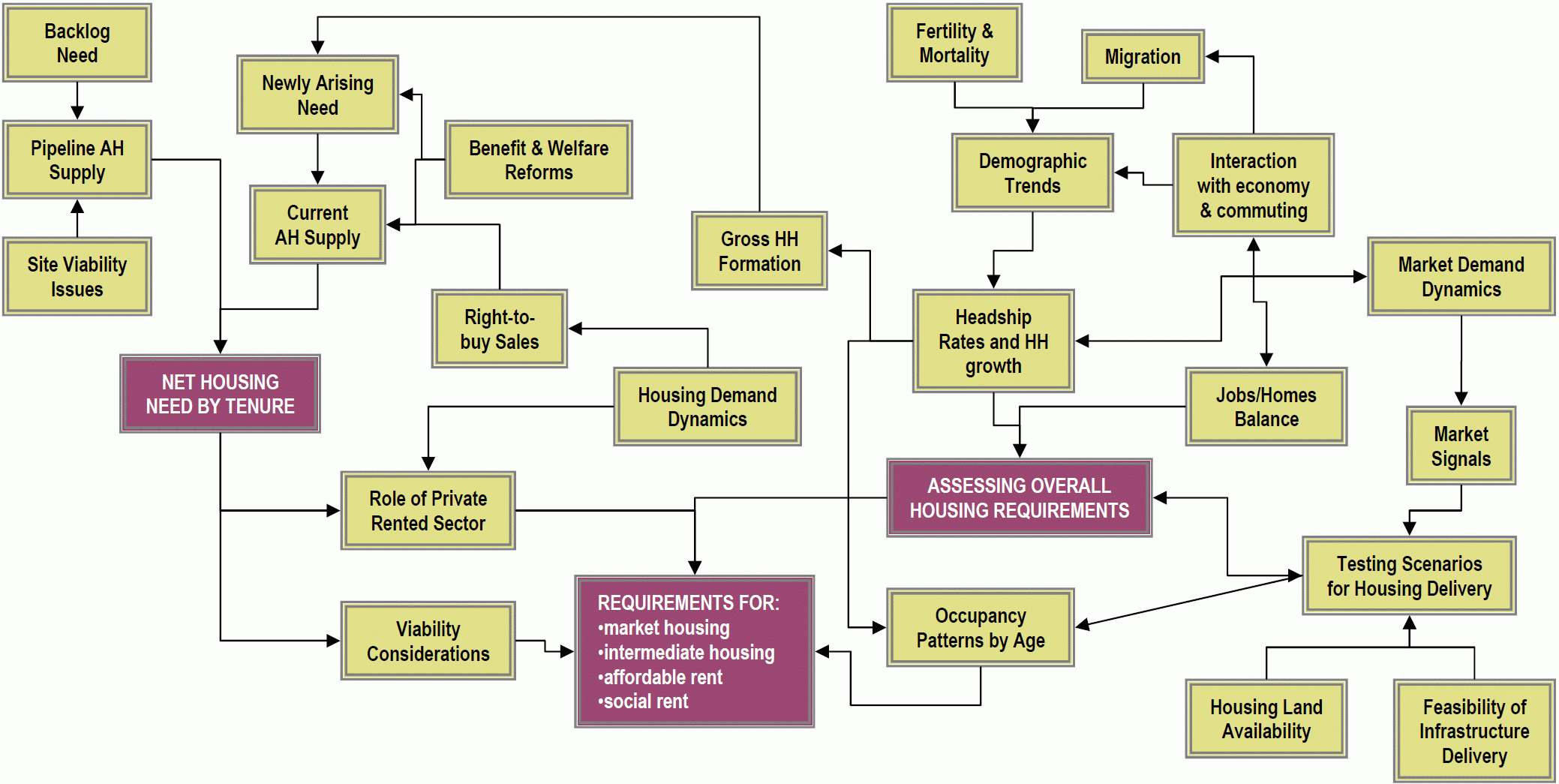NPPF and SHMAs
The National Planning Policy Framework (NPPF) was published in March 2012. This broadens the role of a Strategic Housing Market Assessment (SHMA) by including the requirement to assess overall housing needs whereas previously housing targets were set regionally through the RSS process. This change has already seen a number of Inspector’s Reports highlighting deficiencies in SHMA research which need to be addressed for Local Plans to be considered as sound. Key points include:
- The requirement for housing targets and the derivation of these to be included within SHMA. This entails detailed demographic analysis along with an understanding of any constraints on development such as land supply or infrastructure
- The link between population and employment/job growth needs to be properly understood; realistically planning enough homes for a growing workforce and taking account of potential economic recovery and changes to commuting patterns
The need for sub-regional working – including assessing likely housing requirements in all parts of a Housing Market Area (HMA) and considering the extent to which local housing needs might need to be met in other parts of a sub-region. Evidence of steps taken to ‘cooperate’ with other relevant local authorities must clearly be demonstrated.
Local planning authorities should have a clear understanding of housing needs in their area. They should:
prepare a Strategic Housing Market Assessment to assess their full housing needs, working with neighbouring authorities where housing market areas cross administrative boundaries. The Strategic Housing Market Assessment should identify the scale and mix of housing and the range of tenures that the local population is likely to need over the plan period which:
- meets household and population projections, taking account of migration and demographic change;
- addresses the need for all types of housing, including affordable housing and the needs of different groups in the community; and
- caters for housing demand and the scale of housing supply necessary to meet this demand
Demographic analysis (determining housing targets)
Through our experience and skills with demographic analysis we have developed a methodology to deal with all of the issues highlighted as potential problems by Inspectors and have produced an interactive demographic model which allows for a range of scenarios to be tested. The flexibility of the model is considerably more advanced than other ‘off the shelf’ packages and for example allows testing of different scenarios related to economic recovery and household formation as well as the more traditional variables relating to local demography (e.g. fertility, mortality and migration patterns).
The model can be run for whole local authorities and for sub-areas within a Council area. In addition we provide data for all locations in a HMA to allow authorities to develop sub-regional outputs to assist with discussions under the ‘duty to cooperate’.
Our wider SHMA work still recognises the requirements of CLG guidance. There are moves for this guidance to be updated but our work with the Local Housing Requirements Assessment Working Group (LHRAWG) suggest that revisions will be fairly minor and largely in relation to measuring housing requirements. Our SHMA work therefore demonstrably follows guidance but with the inclusion of an integrated assessment of future housing requirements as required by the NPPF.
Integrating demographic analysis into SHMAs
Whilst deriving housing targets as part of a SHMA has been introduced by the NPPF we are still acutely aware of the need for SHMAs to cover the full requirements of guidance (CLG, 2007); including analysis of affordable housing needs, market housing demand and the requirements of particular groups of the population. To assist local authorities to provide the full range of outputs required by their research we have developed a fully interactive Housing Needs, Market and Demographic Model (HNMDM). The model is structured around three key modules:
- Demography – providing integrated outputs for population, households, dwellings and employment growth;
- Affordable Housing Needs – following CLG guidance to assess backlog need, newly-arising (projected) need and affordable housing supply; and
- Long-Term Housing Requirements – providing outputs on the size, type, tenure and location of homes required
The full model has been used by over 40 local authorities to support Local Plan evidence bases. It allows integrated scenario testing, which can take into account realistic assumptions on the levels and spatial distribution of future housing provision, development viability and local policy choices – ensuring it is sensitive to ‘real world’ dynamics rather than theoretical assumptions.
The findings of the model are brought together as a series of key outputs which are then interrogated to provide evidenced and deliverable policy implications.

The demography module provides full analysis of past trends and future prospects including ‘policy-off’ assessments of housing requirements to comply with NPPF. The module also studies the impact which economic and market conditions could have on migration and headship (household formation) rates along with any potential constraints on housing delivery (e.g. land supply or infrastructure).
The housing needs assessment module follows the Basic Needs Assessment Model advocated in the 2007 SHMA Guidance, developed to consider the impacts of the benefit and welfare reforms being implemented by Government and the impact of policy factors and market dynamics on right-to-buy sales and prospect of renegotiating s106s. This module also considers the extent to which affordable rented and intermediate housing can meet local needs, as well as the role played by the private rented sector housing (supported by Local Housing Allowance) in meeting housing need.
The long-term housing requirements module draws this analysis and key other influences on the housing market to provide a realistic assessment of future housing provision, overall and for different types and sizes of property. This module takes into account likely levels of future housing provision, issues associated with homes-jobs balance, how expected changes in age structures and affordability (including mortgage finance constraints) may influence demand for different sizes and tenures of homes and the influence of development viability and funding on what level of affordable housing provision can realistically be expected. This module provides clear, numerical conclusions regarding the number of homes required, overall and by size for market housing, intermediate housing, affordable rented housing and social rented housing.

